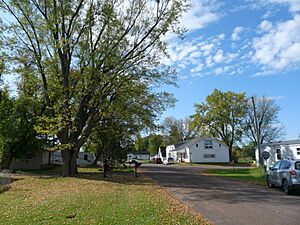Chelsea (CDP), Wisconsin facts for kids
Quick facts for kids
Chelsea, Wisconsin
|
|
|---|---|
|
Census-designated place
|
|

typical scene
|
|
| Country | United States |
| State | Wisconsin |
| County | Taylor |
| Area | |
| • Total | 0.463 sq mi (1.20 km2) |
| • Land | 0.463 sq mi (1.20 km2) |
| • Water | 0 sq mi (0 km2) |
| Elevation | 1,529 ft (466 m) |
| Population
(2010)
|
|
| • Total | 113 |
| • Density | 244.1/sq mi (94.2/km2) |
| Time zone | UTC-6 (Central (CST)) |
| • Summer (DST) | UTC-5 (CDT) |
| Area code(s) | 715 & 534 |
| GNIS feature ID | 1578983 |
Chelsea is a small community in Taylor County, Wisconsin, in the United States. It's a special kind of place called a "census-designated place." This means it's an area that the government counts as a community for population studies, even though it's not an official city or town. In 2010, about 113 people lived there. Chelsea is located about 5 miles (8 kilometers) west-southwest of a town called Rib Lake.
History of Chelsea
How Chelsea Started
Chelsea began because of the Wisconsin Central Railroad Company. In the early 1870s, the railroad built tracks through the thick forests, heading towards Ashland. They set up train stations every five to ten miles along the way. After Whittlesey, Chelsea was the next station, about six miles further. The railroad named the station "Chelsea" after Chelsea, Massachusetts, because many of the people who invested money in the railroad were from Boston. The railroad built a train station and a pumping station to give water to their steam engines.
In 1874, the railroad officially planned out the village of Chelsea.
Growing and Changing
Chelsea's first school was built in 1875. It was a simple one-room building made of wood. The next year, eleven students were enrolled there. In 1876, much of the town, including the sawmill, burned down. But the people quickly rebuilt it.
In 1883, the Wisconsin Central Railroad built a special track from Chelsea to Rib Lake. This was mainly to help the Rib Lake Lumber Company transport its wood products to other places. For many years, this track carried lumber and other goods from Rib Lake through Chelsea. In 1884, the one-room school in Chelsea was replaced with a larger two-room school.
By 1888, four trains passed through the small town every day. There was a morning mail train, an afternoon passenger train, a slow freight train that stopped at every station in the evening, and a faster freight train later at night.
A map from 1913 shows that Chelsea had a post office and a hotel across the tracks from the train station. The school was on the west side of town. The map also showed that the town had grown with more planned areas. A 1911 map of the surrounding area showed that many settlers owned land close to the railroad. Further away, most of the land was owned by lumber companies and the railroad, and it was not yet settled. This time marked a shift from logging to farming in the area.
As the local supply of timber (trees for wood) started to run low, the sawmills changed what they cut. They switched from white pine to hemlock and other hard kinds of wood. The big sawmill in Chelsea finally closed in 1918. The large sawmill in Rib Lake kept running until 1948, then it also closed. The special track to Rib Lake was removed a few years later.
Cars and trucks started to take over from trains for transportation. However, less traffic came through Chelsea when Highway 13 was built to go around the town on its east side. The main rail line through Chelsea closed in 1988.
Chelsea Today
As of 2023, Chelsea is a quiet community with homes spread out along a side-road. It's just a short drive north of Medford. The Pine Line bike trail now passes through Chelsea, using the path where the old railroad tracks used to be.
See also
 In Spanish: Chelsea (Wisconsin) para niños
In Spanish: Chelsea (Wisconsin) para niños


